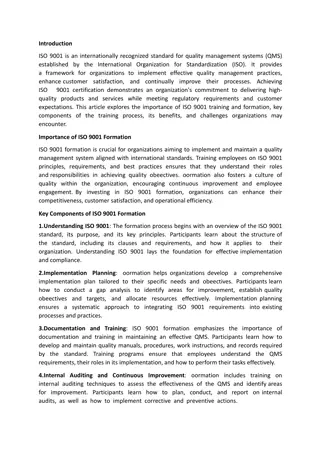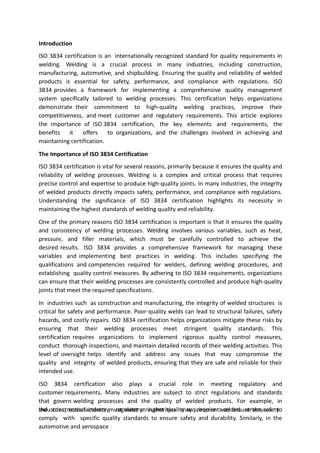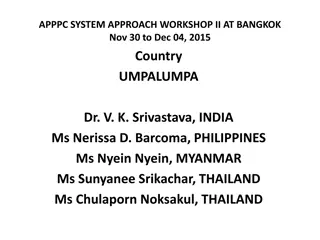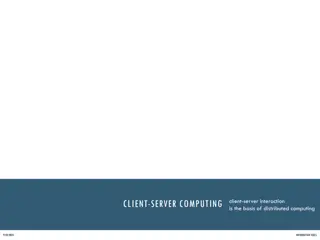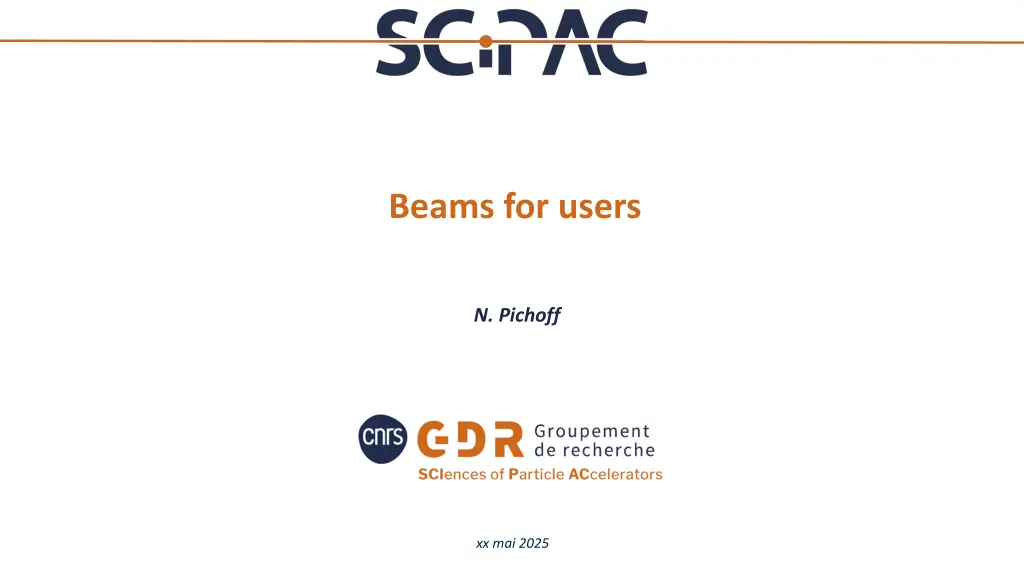
Accelerator Workshop Insights
Explore the world of accelerators through workshops covering topics like beam physics, particle dynamics, and accelerator domains. Learn about the delivery of accelerators and the importance of beams for users. Discover the intricacies of particles in accelerators and their behavior along specific trajectories. Join the workshop to delve into the fascinating realm of accelerator technology and its applications in various domains.
Download Presentation

Please find below an Image/Link to download the presentation.
The content on the website is provided AS IS for your information and personal use only. It may not be sold, licensed, or shared on other websites without obtaining consent from the author. If you encounter any issues during the download, it is possible that the publisher has removed the file from their server.
You are allowed to download the files provided on this website for personal or commercial use, subject to the condition that they are used lawfully. All files are the property of their respective owners.
The content on the website is provided AS IS for your information and personal use only. It may not be sold, licensed, or shared on other websites without obtaining consent from the author.
E N D
Presentation Transcript
Beams for users N. Pichoff xx mai 2025
Transition from SCIPAC simulation workshop October 16-18, 2024 xx may 2025 Workshop ALP-ACC 2
Accelerator Delivery The delivery of an accelerator is a Beam for Users Beam Beam physics xx may 2025 Workshop ALP-ACC 3
Accelerator domains IT Software Coding Hardware Electronics Control-System Cabinets Electrotechnics Infrastructure Electronics Coding Data acq. Electronics Cryogenics Cryogenics RF Amplifier Mechanics LLRF RF physics LHe Water LHe Water Fluid Chemistry Air Fluid Position Diagnostics P-M Interaction Tuning Actuator Chemistry Cavities EM Physics Cooling Air Cooling Actuator Thermic Thermic Object Mechanics Object Mechanics Beam Beam physics Pipes Magnetism Radiation Nuclear Activation Prompt Radiation Nuclear Activation Ionic Physics Prompt Magnet Source Vacuum Atomic Vacuum Atomic Power Supplies Electrotechnics Plasma RF HV Electrotechnics EM Physics Laser Gas Cathode 0 xx may 2025 Workshop ALP-ACC 4
A BEAM ? xx may 2025 Workshop ALP-ACC 5
Beam for users A beam is a flow of particles along a specific axis z Beam ? ?0 users users users users The beam users don t care about the technology providing it ! xx may 2025 Workshop ALP-ACC 6
Particle in dynamics In dynamics system, the evolution of the particle position in the 3D space is described as a function of an independent variable ?. At a given ?, a particle can be completely and uniquely described by a 6-coordinate vector. ?1 ?2 ?3 ?4 ?5 ?6 ?1 ?2 ?3 ?4 ?5 ?6 are the particle position coordinates are the particle motion coordinates i.e.: ?4 6are functions of ??1 3 ?? xx may 2025 Workshop ALP-ACC 7
Particles in accelerator A beam is a set of particles whose average momentum along one trajectory (z) is bigger that its momentum dispersion along all directions. ??=?? ??= ????? ??? ? 2= 1 ?? 2+ ?? 2+ ??2 2 ? 2, ??2 ??2 ?? ? , ? ? is the particle mass ? is speed of light in vacuum ? is time Around this specific trajectory, one can chose : ? ? The position along the trajectory The vertical position ?2 ?1 ? The horizontal position ( ? = ? ?) ? or The time/phase (??: bunch frequency) ?3 ? ? = 2??? ? ? =?? ?? ?? ?? ?? or ?4 The horizontal slope ((un-)normalized) ???? = ?? ?? ?? or ?5 ???? = The vertical slope ((un-)normalized) ? = The kinetic energy ? = ? 1 ??2 ?6 xx may 2025 Workshop ALP-ACC 8
Beam in accelerator A beam is made of a flow of ? [/s] particles. A beam can be made of bunchs of ? particles. ? = ?? ? This distribution of particles can be represented by a distribution function : [m-2.rad-2.s-1.eV-1][/s]. ? ?,?,???? ,???? ,?,? Describing the beam s particle distribution at a given ?. ? ?,?,???? ,???? ,?,? ?? ?? ????? ????? ?? ?? = 1 or ? or ? xx may 2025 Workshop ALP-ACC 9
Beam sub-properties 0 - definition 1 parameter Order-0 momentum: ? : the beam flow of particles ? = ? ? ?? Average/peak Current 80 mA or Charge per pulse/bunch = 320 pC/bch @ 250 MHz or Particle per pulse/bunch = 5 1017part/s = 2 109part/bch @ 250 MHz xx may 2025 Workshop ALP-ACC 10
Beam sub-properties 0 - change 1 parameter The Order-0 momentum can be changed by : x x x x z - Collimation (flow reduction) Only reduction x x - Funneling (flow increase) At different times x x - Injection in ring (flow increase) x x At different phase-space positions or change of charge e e t t xx may 2025 Workshop ALP-ACC 11
Beam sub-properties 1 - definition 6 parameters ??= ?? (6D vector) Order-1 momenta: ? (6D vector) ? =1 ? ? ? ? ? ?? ? =1 ? ?=1 ? ? = ? ? = ? are its transverse positions ?? ? ?? ?? ?? ?? ???? = are its transverse angles ???? = ? = ? is its arrival time is its kinetic energy ? = ? ??,??,?? xx may 2025 Workshop ALP-ACC 12
Beam sub-properties 1 - change 6 parameters The Order-1 momenta can be changed by : dX x x x ?? ?? - Transverse : steering ?? = ???? Distance ? ?? = ?? ? x x x ?? Dpole e e e - Longitudinal : acceleration ?? = ???? ?? ?? distance t t t ?? ?? ? ?? Cavity xx may 2025 Workshop ALP-ACC 13
Beam sub-properties 2 - definition 21 parameters Order-2 momenta: ? (6x6D variance matrix) ??,?= ?? ?? ?? ?? is its rms duration ? ?2 ? ?2 ??= ??= are its transverse rms sizes ??= ? ?2 is its rms energy dispersion ? ?2 ? ? 2 ??= ?? = ?? = are its transverse rms slope dispersion ? ? 2 ??? =?? 2 ? ? ? ? 2 ?? ??= ??? ?? ?? 2 ? ? ? ? ??2 ??2 ? ? ? ? 2 ?? ??= ??= ??? ?? are its normalized transverse rms emittances is its longitudinal rms emittances 2D rms normalized emittances are conserved in 2D uncoupled linear forces 6D rms normalized emittance is conserved in 6D fully-coupled linear forces xx may 2025 Workshop ALP-ACC 14
Sigma matrix 21 parameters Order-2 momenta: ? (6x6D variance matrix) ??,?= ?? ?? ?? ?? ??= ?? ?? ?1?3 ?2?3 ?3?3 ?4?3 ?5?3 ?6?3 ?1?4 ?2?4 ?3?4 ?4?4 ?5?4 ?6?4 ?1?5 ?2?5 ?3?5 ?4?5 ?5?5 ?6?5 ?1?6 ?2?6 ?3?6 ?4?6 ?5?6 ?6?6 ?1?1 ?2?1 ?3?1 ?4?1 ?5?1 ?6?1 ?1?2 ?2?2 ?3?2 ?4?2 ?5?2 ?6?2 Emittance : determinant W4 W5 W6 (W4,W5) (W4,W5,W6) ?12?42 ?1?42 W1 ?42 W2 W3 (W1,W2) (W1,W2,W3) 2D 2D 2D 4D 6D ?12 xx may 2025 Workshop ALP-ACC 15
Example of 6D distribution 21 parameters Ellipsis models @ 3 sigma xx may 2025 Workshop ALP-ACC 16
Beam sub-properties 2 - change 21 parameters The Order-2 momenta can be changed by : x x x ??? - Transverse : (de)focusing ?? distance ?? ? ? ??? x x x ?? ? Qpole e e e - Longitudinal : (de)bunching ?t ?? distance ?? ?? ? ?? ?? t t t Cavity ??? e e e ?t distance ?? ?? ? ?? ?? t t t Dpole xx may 2025 Workshop ALP-ACC 17
Beam sub-properties - changes 28 parameters All change need electro-magnetic fields In conventional accelerator, they are limited to : ~1-2 T in RT magnets Limited by magnetic mater saturation ~10-30 T in SC magnets Limited by quench ~10-100 MV/m in RT RF cavities Limited by cooling ~20-40 MV/m in SC RF cavities Limited by quench Limited by breakdowns Electric efficiency optimization For a given technology order-2 momenta are limited by normalized emittances xx may 2025 Workshop ALP-ACC 18
Beam properties conclusion Generally, an aggregate beam quality could be : - The density of the particle distribution in phase-space. [m-2.rad-2.s-1. eV-1]. ? ?,?,??? ,??? ,?,? The higher the better ! - The emittances : ?,?,??? ,??? ,?,? 6D [m2.rad2.s. eV] (no T-L coupling) [m2.rad2].[s.eV] ?,?,? ,? (no H-V coupling) 4D+2D ?,? ?,? [m.rad].[m.rad].[s.eV] ?,? 2D+2D+2D ?,? The lower the better ! xx may 2025 Workshop ALP-ACC 19
Density evolution - The 6D density of the particle distribution can : - Increase : - from stochastic phenomena (in rings) expected - from property change (H- H+; In+ Im+) - Decrease from diffusion phenomena (everywhere) : - intra/inter-beam scattering - Residual gas scattering - Transport elements variation integrated distribution unexpected - In the same conditions, the emittance varies inversely xx may 2025 Workshop ALP-ACC 20
Emittance evolution - When density changes, the emittance varies inversely + - sub-emittances (2D/4D) can be increased / reduced with coupling in other directions y,t y,t (y,y )(e,t) (y,y )(e,t) (y,y )(e,t) (x,x ) (x,x ) x (x,x ) x 2 2 2 - rms emittances (2D/4D/6D) can be increased from non linear-forces + mismatching r'/R'a r'/R'a r'/R'a 0 0 0 2 2 2 2 1 0 1 2 2 1 0 1 2 2 1 0 1 2 x,y,t r/Ra r/Ra r/Ra 2 2 2 r'/R'a r'/R'a r'/R'a 0 0 0 2 2 2 2 1 0 1 2 2 1 0 1 2 2 1 0 1 2 r/Ra r/Ra r/Ra xx may 2025 Workshop ALP-ACC 21
Space-charge - Beam is made of particles with same charges ?2 ?1 2 Space-charge repulsion force between particles : ?1 23 ?1 2 The denser the beam (in real space), the higher the space-charge force - Space-charge force depends on beam density distribution It is linear ONLY when the beam density is uniform (in 3D) Generally Space-charge force is non-linear Transport of very dense (small, short) beam is submitted to space-charge - The higher the energy, the lower the space-charge Generation of very dense beam has to be coupled with very high acceleration xx may 2025 Workshop ALP-ACC 22
Other machine qualities Other parameters contribute to the technological choice : - The availability : the user has to be sure that the beam properties stay the same during the operation. - The substainability : the impact of construction and operation on environment. - The cost (including risk) : the user want to pay as less as possible for the beam - The procurement cost - The operation cost - Manpower - Energy consumption - Maintenance - Cost of delivered particle can include the availability and substainability. xx may 2025 Workshop ALP-ACC 23
CONCLUSION To build a machine, a technologies shall be selected : 1- if required beam parameters are achievable at the same time. 2- Only if 1 is reached, the aggregated1 cost is the lowest. 1A subjective combination of parameters (availability, construction, operation ) To drive research on new technologies, it could be interesting to quantify a distance with respect of old technologies A pertinent parameter like luminosity, brightness, cost, availability For a given application Mature technology for this application Physical limit Interesting technology for this application Useless technology for this application Technological performance Generally log scale Can be orders of magnitude 1925 2025 2125 xx may 2025 Workshop ALP-ACC 24





